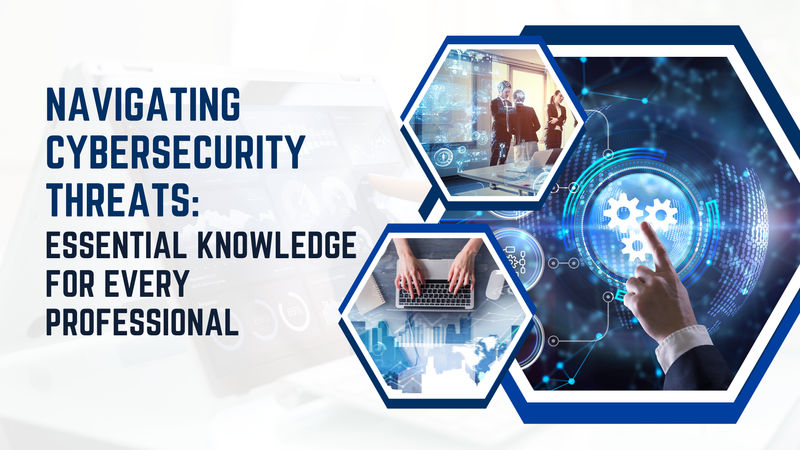
Navigating Cybersecurity Threats: Essential Knowledge for Every Professional
Posted on 03/06/24 By Guest Contributor
Every day, cybersecurity threats are becoming increasingly prevalent and sophisticated. From phishing attacks to ransomware, professionals in every industry should have the knowledge and tools to navigate these risks.
With the number of cyberattacks on individuals and businesses rising, more and more people are experiencing multiple negative consequences. Understanding the possible impact and taking proactive steps are integral to avoiding financial and personal disasters.
Since the majority of cyberattacks achieve success due to human error, cybersecurity training is key to prevention. Let’s take a closer look at its importance and effectiveness.
Understanding Cybersecurity Risks
Every professional, regardless of the industry, should familiarize themselves with the different types of cybersecurity threats prevalent today.
- Phishing Attacks - Involve a hacker posing as a reputable entity to trick individuals into sharing sensitive information.
- Malware and Ransomware -Types of malicious software designed to damage, disrupt, or gain unauthorized access to a computer system.
- Social Engineering - Manipulates individuals into divulging confidential information that may be used for fraudulent purposes.
The consequences of ignoring cybersecurity risks are dire. A successful cyberattack can result in financial loss, the breach of sensitive data, and damage to a company's reputation. It could also potentially lead to legal repercussions if customer information is involved.
Recognizing Cybersecurity Risks & Preventing Attacks
Navigating cybersecurity risks begins with recognizing the warning signs. They include:
Unusual Network Activity
Keep an eye out for any unusual network behavior, such as unexpected data transfers, unfamiliar devices connecting to the network, or sudden disruptions in internet speed. These could be signs of a cyberattack or unauthorized access.
Suspicious Emails and Links
Be cautious of emails from unknown senders or messages that contain suspicious attachments or links. Phishing emails often attempt to deceive recipients into sharing sensitive information or downloading malware. Look for signs of poor grammar, misspellings, or unexpected requests for personal information.
To prevent the attack from succeeding, you must implement a number of preventive measures, including:
Implementing Strong Password Policies
Use strong, unique passwords for all accounts. Passwords should be complex, incorporating a combination of upper and lowercase letters, numbers, and special characters. Avoid using easily guessable information such as birthdays or names.
Regular Software Updates and Patching
Keep all software, including operating systems, applications, and security software, up-to-date. Software updates often include security patches that address vulnerabilities. Enable automatic updates when possible, or regularly check for updates and apply them promptly to ensure protection against known exploits.
Regularly Back Up Data
Regularly backup important data to an external hard drive, cloud storage, or another secure location. In the event of a cyberattack or data loss, having backups can help restore critical information and minimize the impact.
Educate and Train Users
Cybersecurity is a shared responsibility. Educate and train employees on best practices for cybersecurity, including how to identify and report potential threats, the importance of strong passwords, and safe browsing habits.
Use Firewall and Antivirus Software
Install and regularly update firewall and antivirus software to protect against malware, viruses, and other cyber threats. Configure firewalls to block unauthorized access to your network, and regularly scan for malware.
Importance of Cybersecurity Training
Strong cybersecurity training plays a vital role in ensuring that organizations are up-to-date with the latest threats and security protocols. Continuous education in cybersecurity, even for non-technical personnel, is beneficial as it deepens their understanding, heightens their awareness, and enhances their ability to react appropriately to potential threats.
Thankfully, there are various resources available for cybersecurity training. Online courses and certifications provide comprehensive information about different threats and explain how to deal with them. Meanwhile, workshops and webinars offer interactive sessions that can be both informative and engaging.
Beefing Up Cybersecurity Measures
Robust cybersecurity practices are an essential part of any successful business operation. By understanding cyber threats and adopting relevant measures, you can significantly reduce the risk of attacks.
Every professional should find the time to invest in cybersecurity training, irrespective of their field. It's not just about protecting yourself or your organization. It's about fostering a safer digital world for everyone.
Secure your professional future and fortify your workplace against cyber threats by staying informed and educated. Explore Lorman's cutting-edge cybersecurity courses today for a robust defense – because knowledge is the key to a secure tomorrow.
Related Articles
The rapid spread of the COVID-19 is significantly impacting life in the United States. Fortunately for employees and supervisors, there are ways to stay productive and engaged while working remotely during the Coronavirus pandemic.
Artificial intelligence in healthcare is changing our everyday lives in more ways than we can imagine. From new drug development to robot-assisted surgery, AI is taking healthcare to a new level.
There are five generations currently in the workforce. Because of this, it's imperative that organizations understand the importance of leading across generations.


